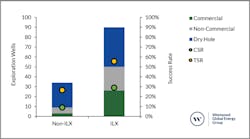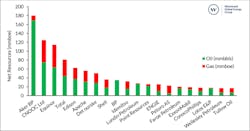North Sea drilling returns remain modest, consultant claims
Offshore staff
LONDON – Interest remains strong for high-impact exploration drilling in the North Sea, according to Westwood Global Energy Group, despite a success rate of only 12% over the past five years.
Between 2015 and 2019, according to the consultant, 124 exploration wells were drilled across the UK and Norwegian North Sea, with 29 finds resulting.
These delivered 1,060 MMboe of commercial resources, replacing 15% of reserves produced over the period, at a total cost of $5.2 billion.
Dave Moseley, senior analyst NW Europe at Westwood, said exploration performance improved from a low in 2015, when there was a commercial success rate (CSR) of only 6% from 32 exploration wells drilled, to an average of 23% over the five-year period.
Although the late 2014 oil price crash reduced drilling activity between 2016 and 2018, improved prospect selection resulted in higher success rates. Last year, drilling levels rebounded while commercial success rates were sustained at 25%.
Sustaining production from existing infrastructure remains the key driver for North Sea exploration, Moseley suggested.
Ninety infrastructure-led exploration (ILX) wells led to 26 discoveries between 2015 and 2019 at a CSR of 29%. And these types of wells added around 750 MMboe to existing production hubs, equivalent to around six months of production over the period.
Non-ILX wells, however, generated only three commercial discoveries at a 9% CSR, and only one of those is thought to be large enough to warrant a standalone development.
Twenty-five high impact prospects (with pre-drill resources ≥100 MMboe) were drilled in the North Sea between 2015 and 2019, including 13 last year. But only one - Aker BP’s Liatårnet - led to a >100 MMboe discovery and this was also the sole play-opening well.
CNOOC’s Glengorm well in the UK central North Sea was the only other discovery in this resource range.
Westwood found that 85 companies participated in exploration drilling between 2015 and 2019: of these, 41 companies made one or more commercial discoveries, including 20 companies which found net commercial resources of more than 10 MMboe.
Exploration performance has improved since 2015 but overall success rates remain mediocre, Moseley concluded, with overall finding costs are high. However, the planned pool of wells for the next 18 months includes 12 high-impact wells, suggesting appetite for risk remains despite current lower oil prices.
06/30/2020


